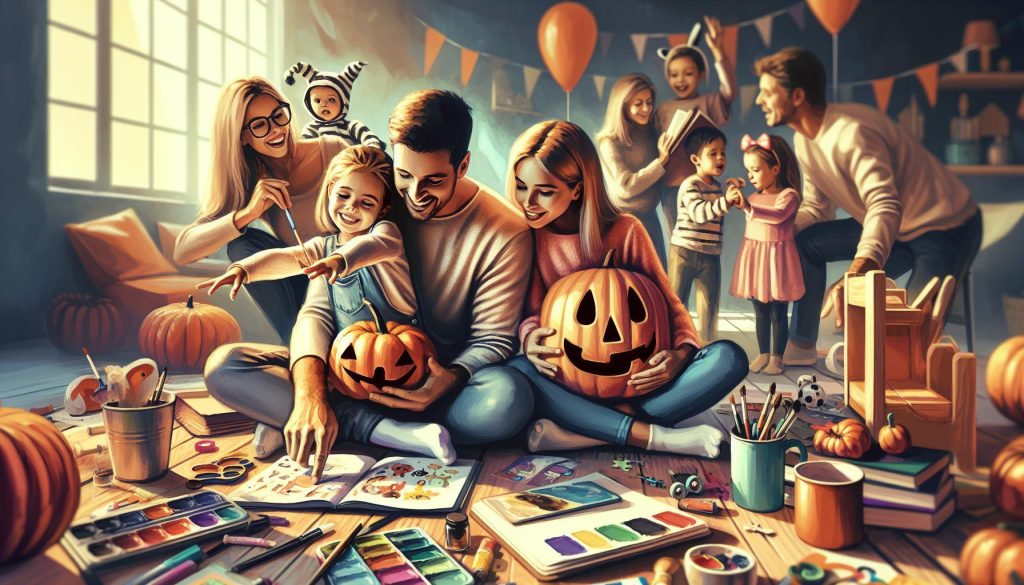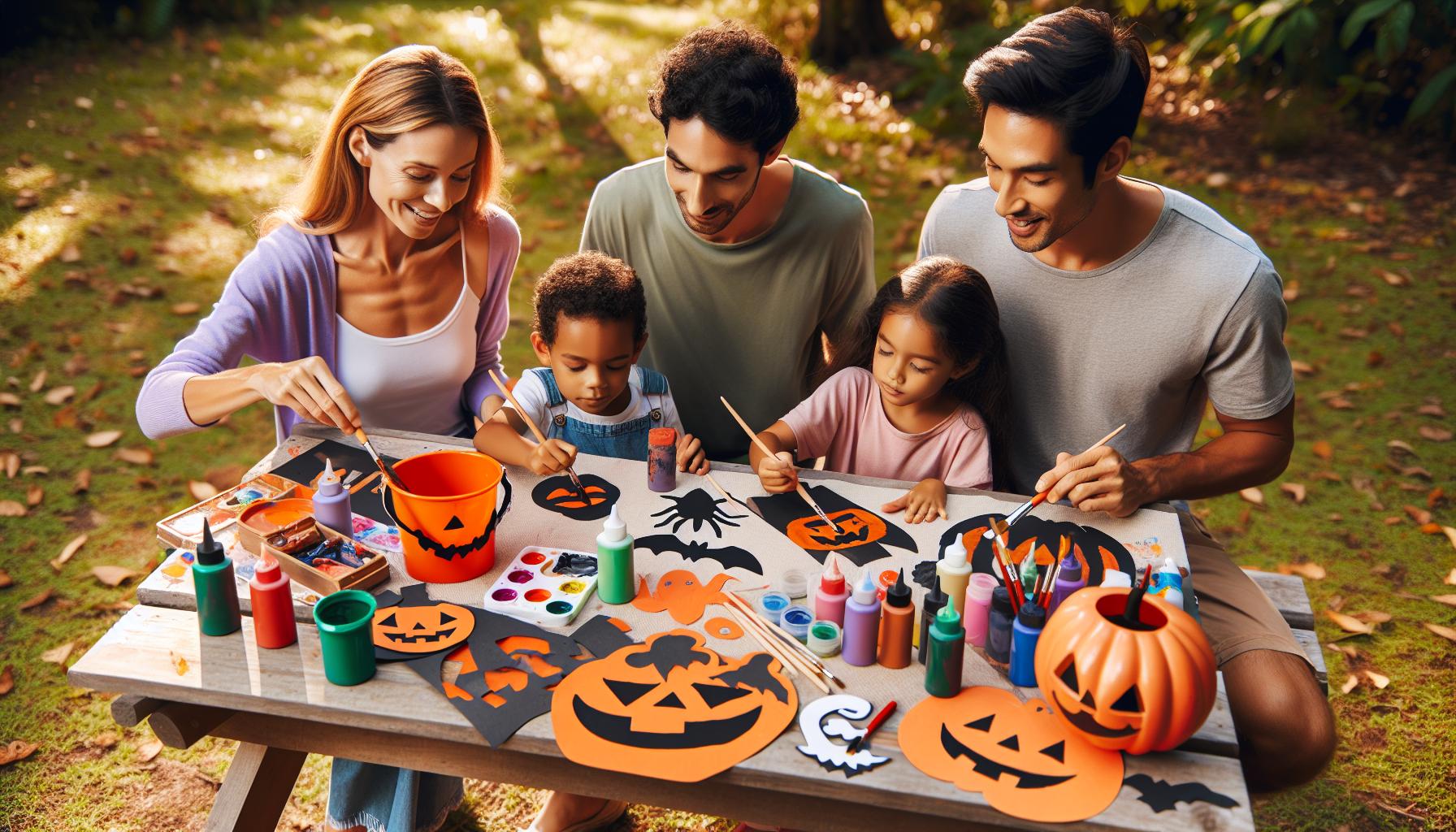Halloween Painting for Kids: Spooky and Artistic Craft Ideas
Get ready to unleash your little ghouls and goblins’ inner Picassos this spooky season! As Halloween approaches, it’s the perfect time to swap out those screen-time shenanigans for some hands-on creativity. Dive into our enchanting world of “Halloween Painting for Kids: Spooky and Artistic craft ideas,” where creepy meets colorful and frightful transforms into fantastic. With our thrilling tips, your kids will craft everything from ghostly masterpieces to pumpkin portraits that would make even the most serious of witches giggle! So, roll up those sleeves and grab the paintbrushes—it’s time to create some boo-tiful art that’s sure to haunt your walls with joy!
Halloween Painting Techniques for Young Creatives
Halloween offers a fantastic canvas for creative expression! here are some engaging painting techniques that young artists can explore to unleash their spooky imaginations.
- Blow painting: Using straws, kids can create whimsical ghost shapes or swirling abstract designs. Just drop liquid watercolors on paper,and then blow through the straw to spread the paint,resulting in ethereal patterns perfect for the spooky season.
- Sponging: A fun technique,sponging allows for texture. Kids can use natural sponges dipped in paint to create backgrounds representing eerie moonlit nights or bubbling cauldrons. This technique adds depth and intrigue to their Halloween masterpieces.
- Salt Painting: By applying glue in Halloween shapes (like pumpkins or bats) and then sprinkling salt over the wet glue, children can add liquid watercolors. As the colors seep into the salt, they create stunning, spread-out designs that mimic the otherworldly beauty of Halloween.
- Finger Painting: Get messy and playful with finger painting! Kids can create pumpkins, witches, or haunted houses using their fingers as brushes.This tactile experience is not only fun but also encourages creativity as children mix colors and shapes with their hands.
Each of these techniques emphasizes fun over perfection, making them ideal for young creatives eager to explore the spirit of Halloween through art. Encouraging individual expression will ensure that each piece produced is unique and personal.
Inspiring Halloween Themes for Artistic Expression
Halloween offers a fantastic platform for unleashing creativity in kids through various artistic expressions. Embracing different themes can invigorate their imaginations while developing their painting skills. Here are some captivating ideas that can inspire young artists:
- Whimsical Witches: Encourage kids to design their own witch characters, exploring different hats, brooms, and magical effects. They can use vivid colors to bring their enchanting tales to life.
- spooky Silhouettes: Using black paint, children can create ghostly silhouettes against a backdrop of sunset hues. This technique introduces them to contrast and layering, showcasing their creativity.
- Greeting Ghouls: Invite kids to paint friendly ghosts, adding their unique twists like silly expressions or fun accessories. This theme can help demystify spooky figures and foster a playful spirit.
- Monster mash: Allow children to design their beloved monsters using non-conventional colors and patterns. This activity promotes free thinking and colors outside the lines while adding a twist to classic characters.
To further aid in exploration, you can set up a simple table that categorizes materials and techniques to be used for each theme:
| Theme | Materials Needed | Techniques |
|---|---|---|
| Whimsical Witches | Watercolors, Markers, Glitter | Mixing, Layering |
| Spooky Silhouettes | Acrylic Paint, Canvas | Brush Techniques, Stenciling |
| Greeting ghouls | Tempera Paint, Brushes | Dot Painting, Sponging |
| Monster Mash | Crayons, Color Pencils | Sketching, Color Blending |
These themes not only cultivate artistic skills but also promote storytelling and imaginative play, making Halloween a fun-filled learning experience. Providing children with a variety of artistic expressions enhances their creativity, encouraging them to experiment while deepening their connection to the festivities!
Essential Materials for Halloween Painting Projects
When diving into Halloween painting projects, having the right materials at hand can make all the difference in unleashing creativity and ensuring a fun experience.Start your spooky crafting adventure with a selection of non-toxic paints that are safe for kids. Acrylic paints are a great choice due to their vibrant colors and swift-drying properties. Additionally, ensure you have a variety of paintbrush sizes for different effects, from fine details to broader strokes.
Investing in a good set of painting surfaces is equally important. Options such as canvases,cardboard,and even pumpkins can be transformed into beautiful Halloween art pieces. To add an extra layer of creativity, consider including glow-in-the-dark paints or metallic shades for that eerie glow when the lights go out!
Don’t forget about the essential tools and accessories that enhance the painting process. These include:
- Sponges for creating unique textures
- Stencils for consistent designs like ghosts or bats
- Palettes for mixing colors
- Smocks or aprons to protect clothing
It can also be helpful to organize your workspace efficiently. A well-arranged table can streamline the painting session, allowing kids to easily access their materials. Consider using a simple table layout for easy reference:
| Material | purpose |
|---|---|
| Non-toxic Paints | Safe and colorful medium for painting |
| Brushes | For various painting techniques |
| Surfaces | Canvas, cardboard, and more for creativity |
| tools & Accessories | Enhance painting and protect users |
step-by-Step Guide to Creating Spooky Masterpieces
transforming ordinary canvases into festive fright-fests requires a touch of creativity and the right techniques. Here are some engaging methods to help young artists unleash their spooky imaginations while painting this Halloween:
- choose Your Palette: Select colors that evoke the Halloween spirit. Traditional shades like orange, black, purple, and green can create an eerie atmosphere. Experiment with glow-in-the-dark paints for a stunning effect.
- Stencil Fun: Using stencils of ghosts, pumpkins, or bats allows kids to easily create detailed designs. Simply place the stencil on their canvas and use a sponge or brush to fill in the shapes.
- Texture Techniques: Encourage young artists to use materials such as sponges, bubble wrap, or even leaves to create unique textures on their paintings. These elements can add depth and interest, making their art stand out.
- Layering Skills: Teach kids to layer their paint for a more dynamic and spooky effect. Start with a base coat, then add shadows with a darker hue to create dimension and enhance the spooky vibe.
| Spooky Ideas | Visual Elements |
|---|---|
| Ghostly silhouettes | White paint on a dark background |
| Haunted House | Shades of black and gray with glowing windows |
| Pumpkin Patch | Vibrant oranges contrasted with green vines |
| spooky Forest | Shadows of trees in dark tones against a radiant moon |
Working on these projects allows kids to harness their creativity while honing their motor skills. Each step–from planning to painting–nurtures their artistic expression. Plus, the thrill of producing something spooky brings an extra layer of excitement to the halloween season!
Safety Tips for Kids’ Halloween Painting Activities
When engaging in Halloween painting activities, it’s essential to prioritize safety to ensure a fun and worry-free experience for kids. Here are some practical tips to enhance safety while keeping the creativity flowing:
- Use Non-Toxic Paints: always opt for non-toxic, child-friendly paints to minimize any risk of ingestion or skin irritation. Look for water-based and washable options that will easily wash off skin and clothes.
- Protective Gear: Equip children with aprons or old t-shirts to protect their clothing.Gloves can also be an excellent idea if they’re using paints that might stain.
- Designated Workspace: Set up a specific painting area covered with newspapers or a plastic sheet to shield surfaces from spills and splashes.Ensure the area is well-ventilated, especially when using spray paints.
- Supervision Required: Always supervise younger children during painting activities. This oversight not only fosters a safer surroundings but also encourages positive interaction and enhances the crafting experience.
Additionally, consider implementing these guidelines:
| Tip | Description |
|---|---|
| Age-Appropriate Activities | Select painting projects suitable for the child’s age to prevent frustration and ensure safety with materials used. |
| Clean Up Materials | Always have paper towels or wet wipes readily available for quick clean-up of spills and to keep hands cleaned. |
| First Aid Ready | Keep a basic first aid kit on hand for minor mishaps like cuts or allergic reactions just in case. |
By following these guidelines, you can create a rewarding and safe painting experience that allows kids to express their creativity while minimizing risks. the goal is to mix fun with safety, ensuring that Halloween painting becomes a cherished and treasured tradition.
Showcasing Your Child’s Art: Ideas for Displaying Halloween Creations
Displaying your child’s Halloween artwork is a delightful way to celebrate their creativity while adding a festive touch to your home. Here are some imaginative ideas to showcase those spooky masterpieces:
- Gallery Wall: Create a dedicated space on a wall to feature your child’s artwork. Use colorful washi tape or adhesive clips to attach their paintings, allowing for easy swaps as they create new pieces.
- Framed Rotating Display: Invest in a couple of frames that can easily open from the front. This way, you can rotate their creations frequently, giving each artwork a moment in the spotlight.
- Art Collage Table: Use a clear acrylic or glass table to showcase several smaller pieces underneath. this creates an interactive display that can be changed out as more art is made.
- Spooky String Lights: Hang your child’s Halloween art from string lights using clothespins. This creates an enchanting display that illuminates their creations, perfect for trick-or-treat night.
Consider adding some seasonal flair to the display by incorporating themed decorations. Below is a simple table of ideas integrating Halloween elements:
| Decoration Idea | Art Enhancement |
|---|---|
| Mini Pumpkins: | place small pumpkins next to the art for a 3D effect. |
| Ghostly Garlands: | String ghost decorations above the artwork to enhance the spooky theme. |
| Cobwebs: | Layer cobwebs around the display for an eerie atmosphere. |
| Autumn Leaves: | Incorporate real or artificial leaves surrounding the art for a fall touch. |
By implementing these display ideas, you transform your child’s Halloween art into a focal point of your home, making this festive season even more memorable.
Engaging Group Projects: Halloween Painting Fun for Classes and Parties
Injecting creativity into group projects can transform a standard classroom or party atmosphere into a vibrant and engaging experience, especially during the Halloween season. Kids have the chance to explore their artistic abilities while collaborating with peers on fun painting activities that align with the spooky theme. Here are some inventive ideas that can cater to various age groups and skill levels:
- Collaborative Mural Projects: set up a large canvas or a roll of butcher paper and let the kids work together to create a mural featuring classic Halloween motifs like haunted houses, witches, or playful ghosts. This encourages teamwork and gives everyone a sense of contribution to a larger artwork.
- Spooky Painting Stations: organize different stations with specific painting themes such as pumpkins, monsters, and scary landscapes. Provide all required supplies at each station, and let groups rotate. This approach helps kids learn new techniques while maintaining excitement with varied subjects.
- pumpkin Art Challenge: Instead of traditional carving, introduce painting pumpkins! Kids can decorate their pumpkins using acrylic paints, glitter, or even glow-in-the-dark paint. Host a pumpkin gallery walk where children can showcase their creations to peers and parents.
- Interactive storytelling with Paint: Combine art and storytelling by inviting children to paint scenes from their favorite Halloween stories or myths. Afterward, each child can present their artwork and the story that inspired it, fostering both artistic expression and presentation skills.
| Activity | Materials needed | Time Required |
|---|---|---|
| Collaborative Mural | Large canvas, paint, brushes, palette | 1 hour |
| Spooky Painting Stations | Paper, various paints, brushes, stencils | 2 hours |
| Pumpkin Art Challenge | Mini pumpkins, paints, decorations | 1.5 hours |
| Interactive Storytelling | Canvas/paper, paints, markers | 2 hours |
Implementing these art activities not only sparks creativity among kids but also enhances social interaction and communication skills. Art projects such as these can make for enchanting Halloween experiences, providing lasting memories for children while nurturing their creative spirits.
FAQ
what materials are best for Halloween painting projects for kids?
When it comes to Halloween painting projects, selecting the right materials can make a significant difference in the experience and outcome. Acrylic paints are an excellent choice for children. they’re easy to work with, dry quickly, and their vibrant colors are perfect for festive themes.Additionally, they can be used on various surfaces, including paper, canvas, and even some types of fabric. For younger kids, washable tempera paints are ideal. They provide a fun, colorful experience without the worry of permanent stains.In terms of brushes, having a variety of sizes can help children explore different techniques. Foam brushes, for example, can create unique textures, while smaller brushes can focus on detail work. beyond brushes, consider using sponges for a fun stippling technique that can bring ghostly effects to life. Palettes or simply disposable plates are useful for mixing colors, while water cups and paper towels help keep the workspace tidy.
Moreover, materials don’t have to be limited to paints and brushes alone. Incorporating different items such as stencils of pumpkins, bats, and skeletons can guide children’s creativity. Paper plates, cardboard, or even rocks can serve as canvases for creating Halloween-themed art, opening up endless possibilities for imaginative creations.
How can halloween painting promote creativity and motor skills in kids?
Engaging in Halloween painting activities is not only fun but also an effective way to promote creativity and enhance fine motor skills in children. Painting allows kids to express their inventiveness freely. They can explore color mixing,blending different hues,and using various techniques,wich fosters an thankfulness for art and helps develop their artistic voice. Such as, instead of just painting a traditional pumpkin, children can experiment with unconventional color schemes or patterns, allowing their individual styles to shine.
In terms of motor skills,the act of holding brushes,controlling strokes,and applying different pressures helps children improve their dexterity and coordination.As they paint, kids practice grasping, moving, and manipulating tools, which enhances hand-eye coordination—an essential skill in other activities such as writing, playing sports, and even daily self-care.
Moreover, when children follow a step-by-step process (like painting a ghost or a haunted house), they also learn to follow directions, which is crucial for cognitive development. As they assess their work, make corrections, and come up with new ideas, they develop problem-solving skills, encouraging a growth mindset where mistakes become learning opportunities.
What are some easy Halloween painting ideas for young kids?
for young children, simplicity is key when it comes to Halloween painting ideas. One straightforward project is creating pumpkin faces on paper plates. Kids can cut shapes out of black construction paper for eyes and mouths, then glue them onto the plate and paint the surrounding area orange. This project is not only simple but also allows for fun self-expression as kids design their unique pumpkin faces.
Another engaging idea is painting halloween-themed rocks that can be used as decorations or garden art. Kids can gather smooth stones and use acrylic paints to create friendly ghosts, scary monsters, or even spooky spiders. This project is an excellent way to combine painting with outdoor exploration, and once dried, the rocks can be displayed around the house or garden to set the Halloween mood.
Mummy art is another easy and enjoyable concept where children can paint a simple white mummy on black construction paper. They only need to paint strips of white for the mummy’s wrappings and add googly eyes for character. These activities are not only fun but help kids practice color recognition and application, and they provide an excellent opportunity for open-ended creativity.
How can parents incorporate educational aspects into Halloween painting activities?
Parents looking to combine education with Halloween fun can integrate various learning opportunities during painting sessions. For example,while painting bats and ghosts,parents can engage kids in conversations about the significance of these halloween symbols,discussing topics like the science behind bats’ echolocation or myths surrounding ghosts. This adds a layer of knowledge while making the art process more enriching.
incorporating color theory is another educational angle. Parents can teach children about primary and secondary colors as they mix paints. for instance, when creating green paint for a witch’s face, kids learn about the relationship between blue and yellow. This practical application of concepts enhances their understanding while encouraging them to experiment and explore.
Moreover, math can come into play through counting and shape identification. Parents can prompt kids to count how many pumpkins they painted or discuss the shapes they used in their designs (circles for pumpkins, triangles for eyes, etc.). Such discussions can happen organically throughout the painting process, making learning feel natural and enjoyable.
What safety precautions should parents take during Halloween painting activities?
Safety is paramount during any craft activity, including Halloween painting. First and foremost, use non-toxic, child-friendly paints, notably for younger children. Many brands offer paints specifically designed for kids that are washable and safe in case of accidental ingestion. Always check the labels for safety certifications to ensure that the materials you are using are appropriate for your child’s age group.
Setting up a designated workspace can definitely help maintain order and safety. Use a table covered with a plastic tablecloth or old newspapers to protect surfaces from paint spills.Consider providing aprons or old T-shirts to keep children’s clothing clean during the creative process. Additionally, having paper towels or wipes on hand can definitely help manage messes quickly, ensuring the painting experience remains enjoyable.
supervision is essential, especially for younger children. Parents should guide kids on how to handle brushes and paint correctly and encourage them to avoid putting paints in their mouths or eyes. It’s also wise to establish boundaries regarding the materials used and the workspace, which can teach children about responsibility while ensuring their safety.
How can Halloween painting be turned into a community or group activity?
Halloween painting can easily transform into a communal experience,fostering creativity and togetherness among friends,family members,or even classmates.organizing a Halloween painting party is an excellent way to bring people together. Incorporate different painting stations, each featuring various Halloween-themed projects like painting canvas bags, crafting spooky backgrounds on paper, or decorating pumpkin rocks. This variety allows participants to explore different techniques and ideas while celebrating the Halloween spirit.
When organizing a group activity, it’s beneficial to prepare in advance. Parents can create a simple painting schedule to ensure everyone has ample time at each station. Inviting children to work in pairs or small groups encourages social skills, such as cooperation and communication, as they share tools and ideas. Additionally, this allows for larger-scale projects, such as a community mural, where everyone contributes to a single piece of art.
To highlight the community aspect further,consider hosting an exhibition day after the painting activity where kids can showcase their masterpieces. Parents and friends can enjoy refreshments while recognizing each child’s work, promoting a sense of accomplishment and community pride. This shared experience not only emphasizes creativity and artistry but also cultivates lasting friendships and memories during the Halloween season.
Final thoughts
As we wrap up our exploration of Halloween painting for kids, it’s clear that this festive season offers a wonderful opportunity for creativity and skill-building. Engaging children in artistic activities not only nurtures their imagination but also enhances fine motor skills and fosters emotional expression. Whether you choose to create spooky landscapes or whimsical character designs, each stroke of paint can be a memorable part of their Halloween experience.
by incorporating simple techniques like sponge painting,finger painting,or using stencils,you can easily tailor these projects to suit different age groups and skill levels. The data shows that hands-on activities, like painting, can substantially boost a child’s confidence and independence, making each completed artwork a badge of honor.
As you embark on your Halloween crafting journey, remember to keep it fun and pressure-free. Celebrate the process of creation as much as the final product. So gather your materials, unleash your inner artist, and make this Halloween a colorful party filled with laughter, creativity, and, of course, some delightful spooky touches! Happy painting!




